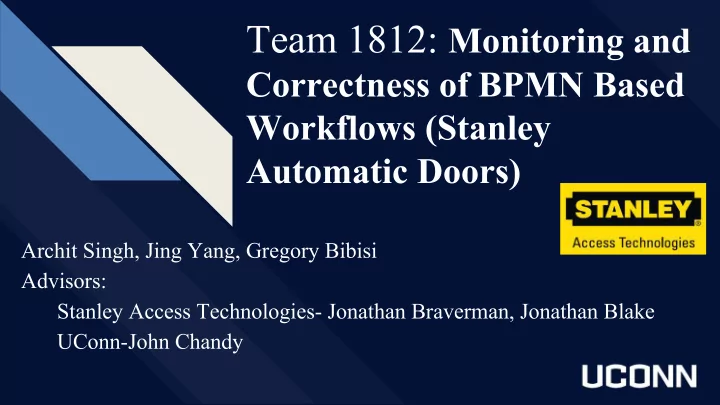

Team 1812: Monitoring and Correctness of BPMN Based Workflows (Stanley Automatic Doors) Archit Singh, Jing Yang, Gregory Bibisi Advisors: Stanley Access Technologies- Jonathan Braverman, Jonathan Blake UConn-John Chandy
Project Overview Stanley Access Technologies • Dura Glide Slide Door System • Aluminum panels that are driven with a motor and a belt system Stanley needs a system to diagnose problems in the automatic doors • Faults in sensors, wiring and other accessories • Require us to design a system that detects these anomalies • Microcontroller reports via bluetooth to an Android app to technician with recommendations
Team Objectives Measure and communicate all relevant information • Measure – Use a current sensor to read the motor’s current, use the ATMega ADC • ACS712 – Use the RS232 from the DCU to communicate with ATMega • MAX3232 – Test the I/O’s of the DCU with multiplexer • 16-Channel Analog/Digital Multiplexer breakout • Communication – Information fed into ATMega, then serial communication is set up with the Bluetooth – The App has to be able to receive and send messages to and from our system
Dura Glide Slide Door Setup 1. Motor 1 2. MC521 PRO Control Box (DCU) w/ Terminal Plugs 3. SU-100 Motion Sensor 4. Solenoid Lock
Sensors SU-100 Motion Sensor • Unidirectional or bidirectional sensing – Senses motion at a threshold of 2 inches/s Stanguard Threshold Sensor • Powered by DCU (14V) 1A max • Reflective infrared sensor
Motor 1 • Requires a voltage supply of 120VDC • Armature resistance of 12 Ohms • Connected to a relative encoder • Controlled by DCU, DCU controlled by rotary switch/encoder
Motor Test- Total Input Voltage ● Measured input door system voltage is 117V RMS. Rated voltage is 120V RMS ● Motor supply voltage(Vo) is 91V RMS DC voltage supply to the Motor DC power supply to the door system
Motor Test- Motor Voltage ● Back EMF(Ve) is 85V RMS which equal to the product of angular velocity of the motor(w) and back EMF constant of the motor(Ke) ● Different direction ● Armature resistance(R) 12 ohm Motor voltage when door open Motor voltage when door close
System Design
Command Data Format
MAX232 • DCU: RS232 Port • Requires a Level Shifter that will not destroy the serial pins on the ATMega328P • MAX3232- – Runs at 3 V and communicates with 5V – Using MAX3232: • Includes the necessary 0.1 µF charge pump capacitors • Works at broader voltage range than MAX232 (3-5.5V)
ACS712 Current Sensor ● Sensor to monitor motor current ○ [0-1A] ● Needs to read information without disrupting ● Electrically Isolated Current Sensor ● Produce Analog output
Current sensor testing Data • Raw analog output from the current sensor • Map the voltage from 0 to 5V, map the current from 0 to 1A
16- Channel Analog/ Digital Multiplexer Breakout ● I/O’s from the Terminal Plugs on the DCU ● From the schematics of the plugs, there are 12 inputs and 6 outputs ○ Plan to use 2 MUX to accommodate for the 18 inputs ○ Selector ports of the 2 MUX will be connected to the same ports on the ATMega ● The 6 outputs require a 5 volt pull-up along with a 1K resistor in series ○ Limit current flowing in the circuit and to account for unpredictable fluctuations while in operation
MUX Connection and Code Door While Closing Door While Opening
ATMega328P XPlained Mini • Need a microcontroller that can connect with the DCU, motor and bluetooth • Needs to transmit all of the information to the bluetooth • Need microcontroller with adequate ports for the bluetooth connector • ATmega328p has built in UART to communicate with the bluetooth and ADC pin to receive the analog and convert signal • Our goal is to receive serial signal and transmit the signal to bluetooth • Right now, it can receive serial signal
Atmel Transmitting and Receiving ● For bluetooth and DCU communication, the serial communication (receive and transmit) ● Built in USART
Updated Budget Stanley provided spare equipment and components Multiplexer Breakout $4.95 x2 ($9.90) Board Max3232 Breakout $5.95 x2 ($11.90) Board Current Sensor $7.95 x3 ($23.85) ACS712 Total Budget: $45.65
Next Steps • ATmega328 P – Communicate with DCU through MAX232 – ADC code – I2C communication with Bluetooth • Wiring Simplification • CSE – Communication in serial signal through cloud or a device via Bluetooth
Thank You
Recommend
More recommend